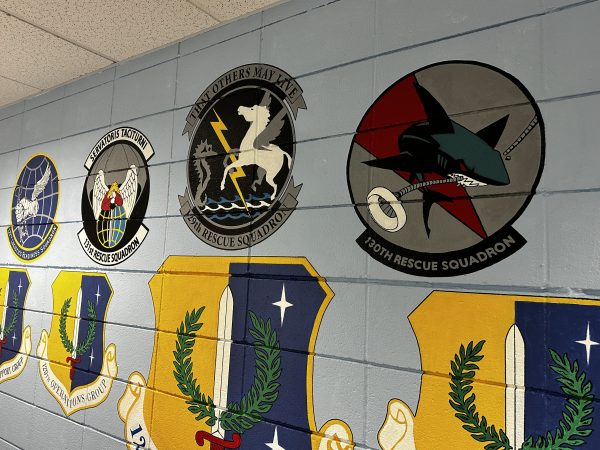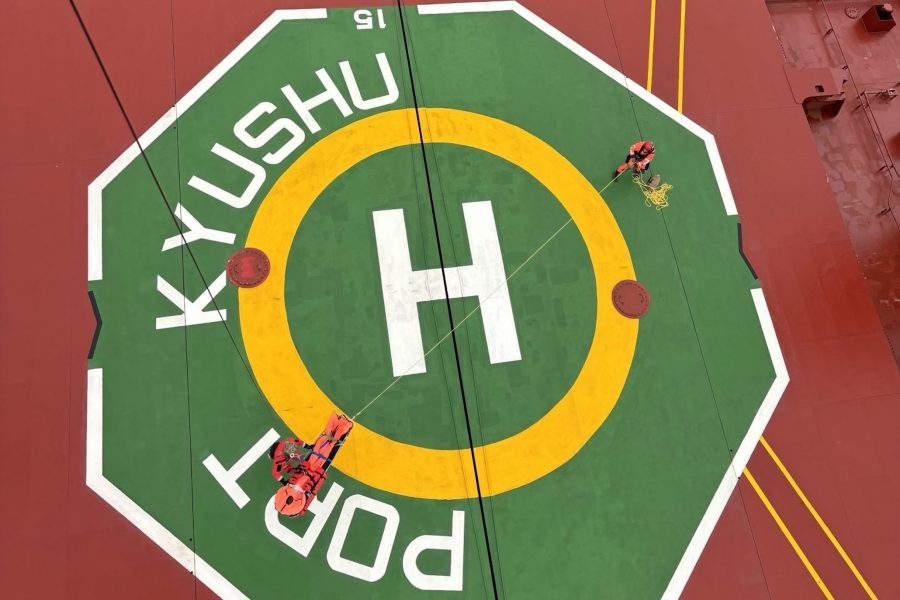This is the second in a two-part series based on exclusive interviews with five Airmen who helped save a patient’s life in a long-range rescue mission Oct. 9. Read Part 1 here.
On the afternoon of Oct. 9, about 20 Airmen were somewhere over the Pacific, aboard two HH-60G helicopters and two HC-130J fixed-wing aircraft, flying to pick up a patient in life-threatening condition aboard a bulk carrier about 500 miles off the coast of San Francisco.
Flying helicopters far from shore is a high-risk mission few other organizations on Earth can do, but the California Air National Guard’s 129th Rescue Wing pulls it off on a regular basis, in part because they can refuel the HH-60s mid-flight via hoses trailing from the HC-130Js.
While the helicopter crews took fuel from an HC-130J visiting from Davis-Monthan Air Force Base, Ariz., the other HC-130J, flown by mission commander Lt. Col. Christopher Nance, raced ahead to make contact with the bulk carrier, Port Kyushu.
One of the Airmen onboard, aircrew flight equipment specialist Staff Sgt. Mike Scheglov was a native Russian speaker and had been brought onto the mission that morning to talk with the ship captain, who the wing believed spoke Russian. Now it was time to find out.
“Initially it was just one of the crew members and I said, ‘do you speak Russian?’ And this guy went into a full-blown conversation in Romanian,” Scheglov recalled. “I don’t speak Romanian, it’s a totally different language. I’m like, ‘oh good Lord I just made this whole flight for nothing.’”
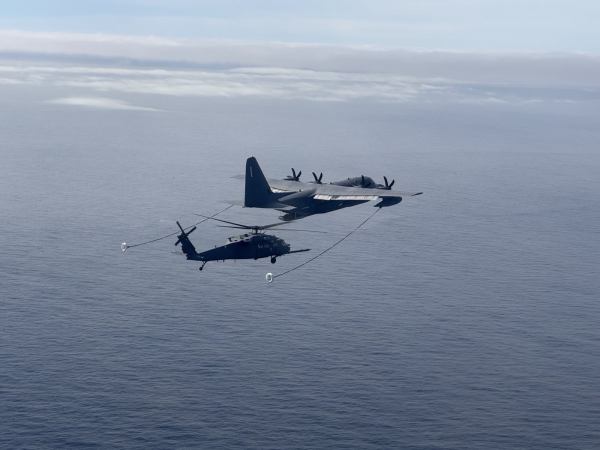
But the crew member eventually got the captain on the radio and yes, he spoke Russian. Scheglov told the captain how to prepare for the rescue, which saved precious time when the HH-60s arrived 45 minutes later.
“The ship was positioned and ready to go, the patient was packaged and ready,” Nance said. “We went from what potentially could have been an hour on scene to, like, under 30 minutes.”
The seas were calm that day, but it would be a long hoist ride down to the Kyushu for the two Pararescue Jumpers (PJs) aboard the pickup helicopter. The HH-60 hovered about 100 feet above the ship to avoid the cranes on either side of the helipad, which was too small for an HH-60 to land on.
Hoist work is a delicate balance for the special missions aviators (SMAs) who work in the back of the helicopter, explained Senior Airman Reese Williamse, a SMA on the other HH-60 that day. SMAs have to keep an eye on the person being hoisted, on the steel cable connecting them to the helicopter, and on their surroundings.
Hoist too fast and you might hurt the person being hoisted, but going too slow extends the vulnerability period. Too much slack can weaken the cable or get it wrapped around a body part or an obstacle. Too little makes it tough for the person to unhook, and if the helicopter moves then it could throw them into the ship’s rail and over the side.
“You keep that fine line of cable slack while also scanning around the aircraft, staying calm, and talking to your pilots,” he said. “I like to say you’re Bob Ross in the back, painting a picture.”
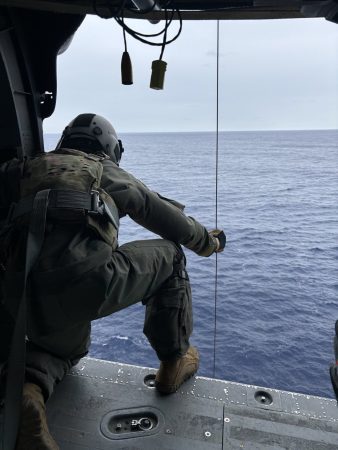
The crew of the Port Kyushu were fascinated; after all, two helicopters had just appeared over the middle of the Pacific and dropped two men in bright red anti-exposure suits on their deck.
“You could see them just kind of stunned at what was going on,” said one of the PJs, Senior Airman Connor, whose full name was withheld for security reasons.
Once on the deck, Connor and his fellow PJ, Tech Sgt. Sean, met the captain, assessed the unconscious patient, then packaged him onto a litter. With no easy way of carrying him onto the helipad, the Airmen pantomimed instructions for the crew to form a kind of train.
“That was one of the coolest moments, working with this crew that didn’t speak English to get their friend and crewmate where he needed to go,” Connor said. “There was no translation, but everybody understood. You could see from their body language that they were appreciative and super willing to help.”
Once the patient was on the helipad, the PJs radioed the helicopters for a pickup.
“This is where you see the skill of the 129th, because everybody is working together here,” Connor said. “The pilots are dealing with a small area to get the hook in place: they are dealing with the ship cranes, so they can’t just come in from any angle. They are dealing with the movement of the ship. But they come in and drop the hook basically right in our hand. That just comes from practice.”
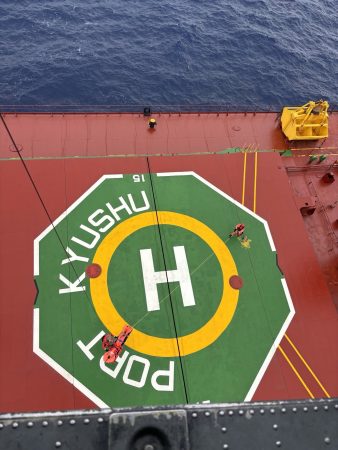
The PJs did forget one thing: a Port Kyushu life buoy to commemorate the rescue. The halls of the 129th Rescue Wing’s squadron buildings near San Jose are lined with buoys given by the crews of dozens of ships from which they’ve rescued patients since 1975.
“We were so focused that that slipped our mind,” Connor said. “The PJs watching us from the other helicopter saw us coming up and they were like ‘they didn’t get the life ring.’ They realized it before we did.”
The Way Back
The first hour of the flight back was an intense one for the PJs, who had to reassess the patient, hook him up to their monitors, put him on oxygen, and get an IV in: a tough task with a cold, severely dehydrated patient on a loud, moving helicopter. The PJs kept an eye on his vitals, but he remained stable and unconscious throughout the flight. It just wasn’t clear what had endangered his life in the first place.
“It could have been many different things, but there was no definitive sign telling us what exactly was wrong,” Connor said.
Throughout the flight, the medics were in close contact with doctors back home, but they too were stumped. Day turned to night as the helicopters flew about 300 feet off the water for much of the way back, staying low to give the patient as much oxygen as possible. It wasn’t until about halfway through the return flight that Connor had a chance to think about anything else.
“That’s a big moment, when you have five minutes to sit back and take care of yourself,” he said.
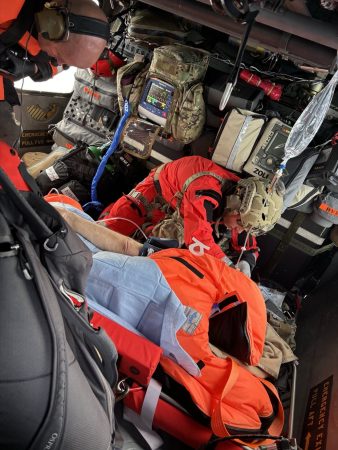
This was Connor’s first rescue as a fully mission-qualified PJ after shadowing a few previous ones and graduating the 2.5-year training pipeline just five months earlier. But the Kyushu job felt like any other practice run.
“At no point did I feel like I was doing anything that I had never done before or that was out of the norm,” he said. “It all felt very calm.”
The helicopter crews wore airtight anti-exposure suits to keep them warm if they had to bail into the cold Pacific, but they grew pungent in the night air, especially when the PJs asked the pilots to turn up the heat to keep the patient warm. Still, at least the PJs could move around a little, while the helicopter pilots were bound to their seats throughout the journey.
“The biggest surprise for me was that my a– didn’t hurt,” said Capt. Parker Imrie, the pilot on the lead helicopter. “I’ve flown three, four, five-hour training sorties where I can barely walk afterwards. And then this was the longest continuous flight I’ve ever done, nine and a half hours, and I was definitely ready to not be sitting any more, but it was fine.”
Back in the cabin, Williamse’s knees and lower back grew sore from spending all day crouched or hunched over.
“I was doing all sorts of stretches,” he said. “That is one plus-side of being in the back.”
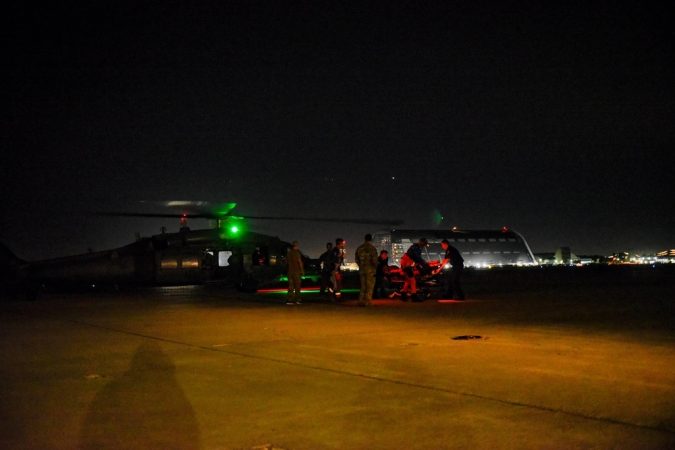
Nance’s C-130 landed back at Moffett Field a little after 9 p.m., about 10 hours after it had first taken off, while the HH-60s followed about 15 minutes behind. The helicopters could have flown to Stanford Hospital, but the wing decided it would not be worth the additional risk after such a long flight. Instead, Connor and Sean hopped into an ambulance for the 25-minute drive.
“We wanted to be able to give a handoff at the hospital,” Connor said. “We walked into the ER in our dry suits with 30 people waiting for us.”
Back at base, the aircrews debriefed, then the helicopter crews reconvened at their squadron heritage room, a lounge adorned with thank-you notes from old rescues, photos of past deployments, and totemic depictions of the jolly green giant, a symbol of Air Force search and rescue dating back to the Vietnam War.
“Even though you’ve been flying for hours, when you finally get back you can’t just go home and go to sleep, because you still have a sense of adrenaline,” Williamse explained. “So we usually come in here, chill out, drink a beer or two, and relax until you start getting tired.”
About two weeks after he got picked up, the patient was on the mend from what doctors diagnosed was a neurological problem. The 129th Rescue Wing asked not to share specific details out of concern for his privacy.
“When I heard that the patient was talking again, was back to normal, it made everything that I’d gone through to get to that point feel very worth it,” Connor said. “I’m fully confident that any one of the new PJs that I just graduated with could have done that exact mission. But I’m grateful that I’m on this team and was given that opportunity.”
And Scheglov? He ended the day with a keepsake of his own, though it requires explanation. The shoulder patch for the 130th Rescue Squadron, the unit which flies the HC-130J, depicts a shark biting into an aerial refueling hose–a twist on the emblem of the San Jose Sharks, the nearby professional hockey team.
Airmen at the 130th wear a version of the patch with a baby shark on it until their first rescue mission or deployment, after which they wear the grown-up shark version. Thanks to his vital translation work, Scheglov got the grown-up shark, making him an honorary 130th member.
“I’ll wear it with pride,” he said.
A month later, the wing was back at it, rescuing a 79-year-old fisherman with stroke-like symptoms about 400 miles off the coast of San Diego. This time they got the life buoy.
